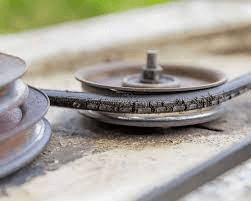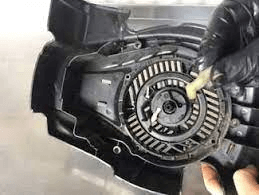Table of Contents

If the trigger on your lawn mower isn’t working, you won’t get anywhere. Mowing becomes impossible if your mower requires you to pull a cable to start it. It’s annoying to try different troubleshooting methods for the Lawn Mower Pull cord not catching before determining that the mower’s pull cord is broken rather than needing more gas.
Here we’ll break down the inner workings of a lawnmower, discuss some potential reasons why your pull cord could not be engaging, and provide some solutions.
Lawn Mower Pull Cord Is Not Catching – Fix the Problem
It’s common for a lawn mower to break at the drawcord. These problems have straightforward solutions. Issues with the mower’s draw cord not catching are common and can be caused by
- The first problem is that the pull cord is broken or damaged.
- Pulley pawls that have been harmed in the course of the use
- Broken pulley for the emergency cord
- An internal pull recoil spring has snapped, and the system is no longer functional.
- Other Reasons Your Lawnmower’s Cord Won’t Pull
It’s embarrassing to pull the starter cord and have no resistance, sending you flying backward, and it’s infuriating when nothing you try works to get the lawn mower going. Lawnmowers that have seen a lot of users tend to have more issues like this.
Damaged or Broken Pulley
You can’t do anything without the pulley. The pulley serves as a guide, a feeder, a place to stash the pull cord, a place to hold the coil spring, and a place to store the pawls. The pulley’s plastic construction makes it vulnerable to breakdown. If the pulley is broken, the cable can’t smoothly circle it. A jam between the pulley and the rope will prevent the machine from starting.

Follow the instructions provided to resolve this issue.
- Take the spark plug wire out of the plug.
- Yank the plug out all the way.
- Insert a screwdriver into the recoil and lock it into place.
- Cut the cord
- Drop the screwdriver
- Take out the central nut
- Take off the friction plate
- After that, replace the old pulley with the new one.
- Align it with the housing post
- Now, turn the pulley clockwise to wind up the spring.
- Put the screwdriver in to keep the pulley in place.
- Don’t remove the screwdriver and reconnect the power source.
- The next step is to remove the screwdriver gradually.
- Slowly wind the rope up to the top.
- Return the key to the ignition and crank the engine over for the fifteenth time
- Hook up the spark plug wire.
- Attempt to start the engine.
The mechanism has a problem, as the pull recoil spring has snapped.
The starter cord can’t retract and be stored in the pulley if the pull recoil spring within the starting mechanism is damaged. If the recoil starter spring has snapped, you must replace the entire unit. For a reasonable price, you can purchase complete new units with preloaded springs and cords.
Pulley pawls
Plastic pawls are commonly used; however, they eventually wear out and crack. Damaged pawls prevent the flywheel from engaging the receiver and turning the engine over.

Follow these procedures to inspect the lawnmower’s pawls for damage:
- Pull the ignition plug out. A good rule of thumb when servicing a lawnmower is to keep the ignition switch in the “off” position.
- Just take off the starting cover, and you’ll see the part.
- Take off the pawls’ central bolt and cap.
- Take the pawls off and inspect them for excessive wear or damage.
- Slid the replacement pawls into the slots left vacant by the old ones.
- Remove the old nut and cap and replace them.
- Put back the starter and make sure it’s working by pulling the cord.
- The pawls interact with the flywheel recipient, which is often a metal cup. If the flywheel receiver is worn, the pawls won’t be capable of engaging, and the engine won’t catch.
Broken Pull Cord
A non-functioning pull cord prevents the starter recoil from turning the crankshaft adaptor, which prevents the engine from starting. Replacement of a pull cord is more accessible than replacement of a broken one.
Follow these directions to replace a worn-out cable:
- Take off the cover of the starter.
- You should cut the new cord’s length to match the old one’s length. We shouldn’t miss the old cable just yet.
- Unplug the rusty starter. To prevent the pulley from collapsing, you can secure its spokes with a screwdriver or a punch.
- Discard the worn-out pulley’s rope.
- Put the new cord through the pulley and tie a knot in it.
- You will attach the draw handle and secure it in place with a double knot.
- Take out the screwdriver and let the pulley wind back.
- Insert the unit back into the starter’s housing.
- You must rewind the pulley spring if the cord is severed before a replacement line can be attached.
- Wrap the cord around the pulley and count the revolutions to determine how many times the spring must be wound
Other Reasons Your Lawnmower’s Cord Won’t Pull
One or both of the pawls on your lawnmower’s pulley may be broken, or the pulley itself may be worn out, which would prevent the cord from being pulled. There are, however, other potential factors that can interfere with your mower’s performance. The critical point is that different manufacturers have varying standards and procedures. Yet, while all mowers will share a standard set of components, how those components are assembled will vary from brand to brand.
Most lawnmower components are made of plastic. Once damaged, these plastic components quickly wear out and fail. Most mower manufacturers use plastic members instead of metal to keep their prices low and remain competitive. Like the pawls and the pulley, the flywheel receiver can wear out and break.
Conclusion
It is concluded that, If your mower breaks down, you might not have to shell out a lot of cash for repairs. When you understand how everything is supposed to work, it’s much simpler to pinpoint the source of the issue. In addition, if you are competent with mechanical components, you can resolve the problem quickly. Brand, model, starter, recoil, and flywheel assembly info is required. An expert look at the machine is recommended if you are unsure about your mechanical aptitude.
